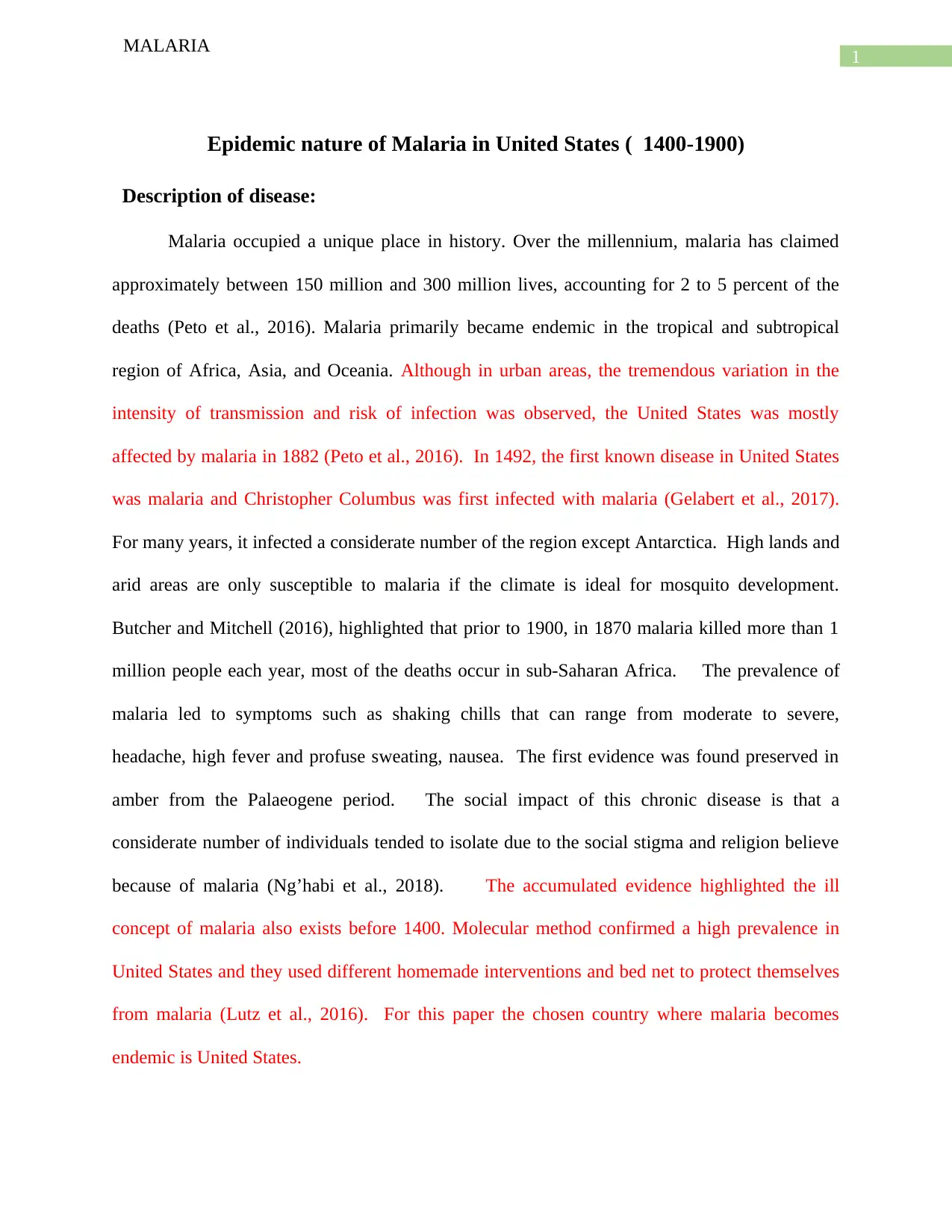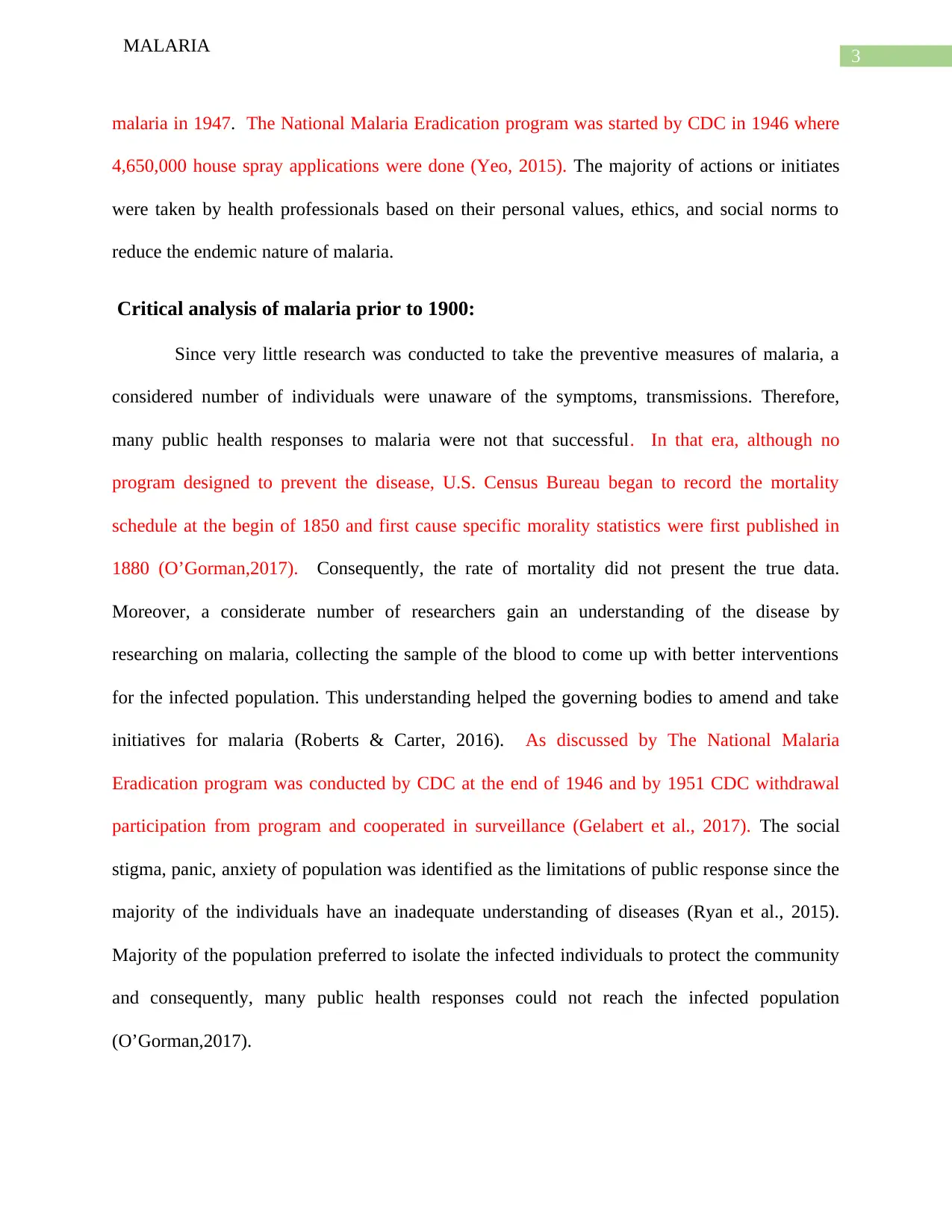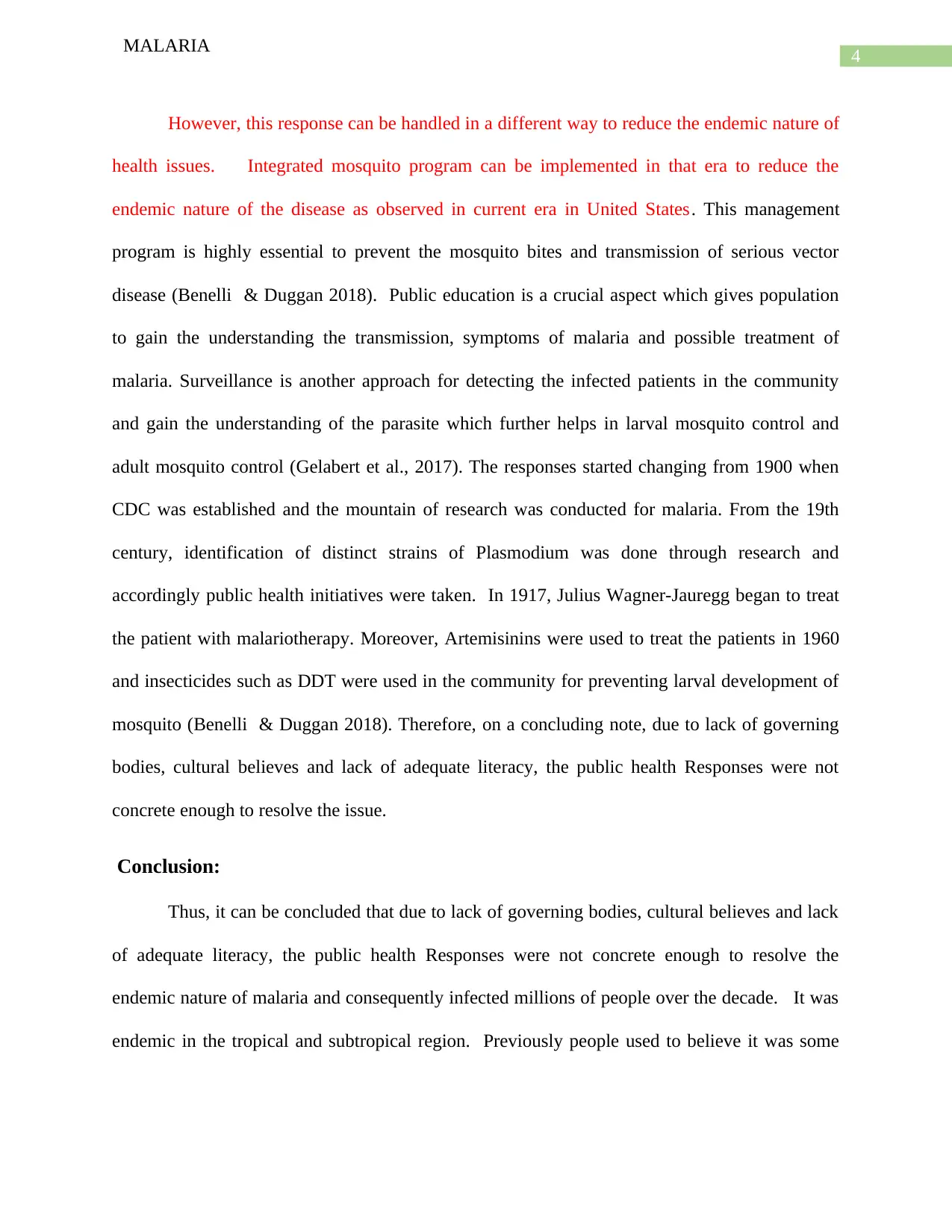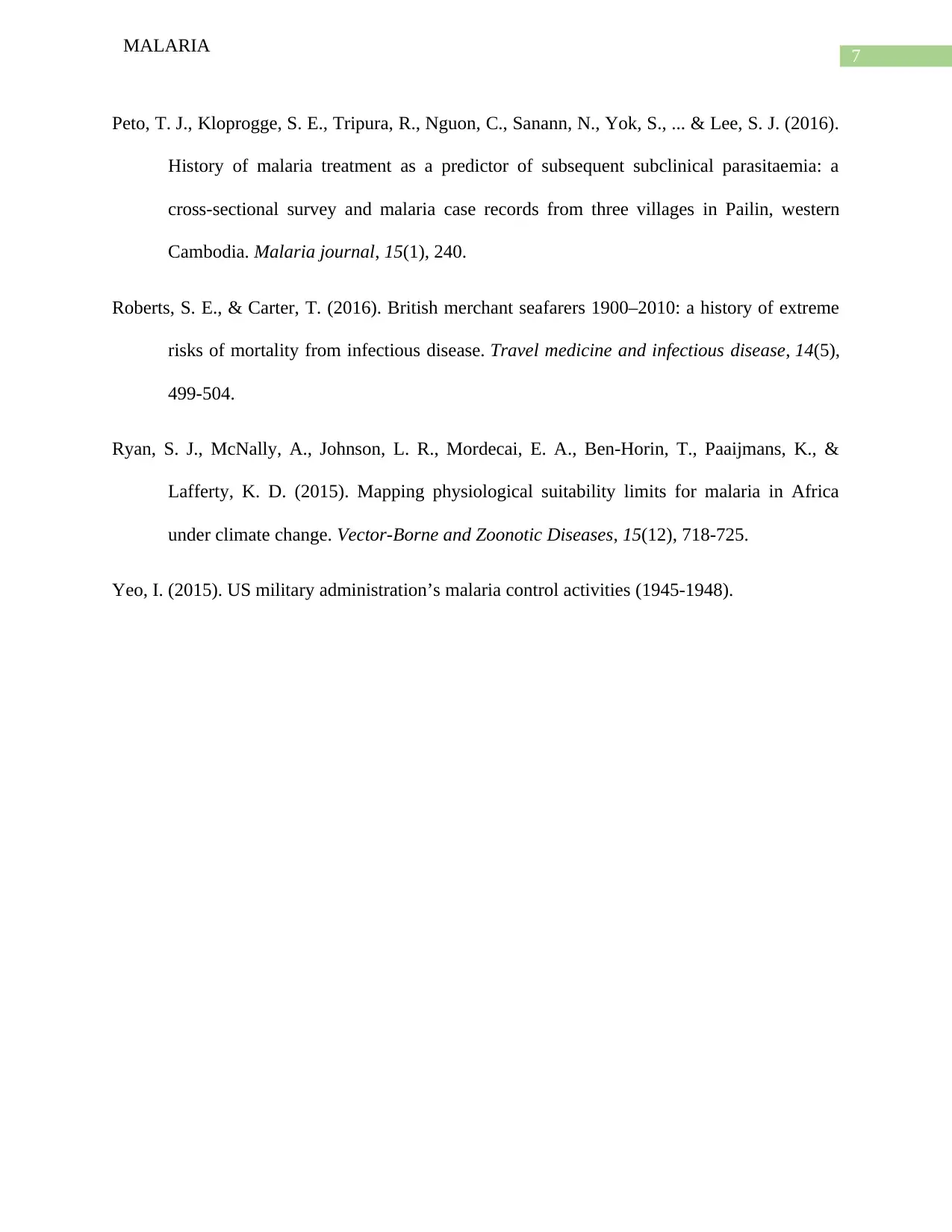Epidemic nature of Malaria in United States (1400-1900)
VerifiedAdded on 2023/04/23
|8
|1879
|71
AI Summary
This article explores the epidemic nature of Malaria in United States from 1400-1900. It covers the symptoms, transmission, and public health responses to the disease. The article also highlights the limitations of public health responses and suggests integrated mosquito programs and public education as crucial aspects to reduce the endemic nature of the disease.
Contribute Materials
Your contribution can guide someone’s learning journey. Share your
documents today.

Running head: MALARIA
Name of the student
Name of the university
Author note:
Name of the student
Name of the university
Author note:
Secure Best Marks with AI Grader
Need help grading? Try our AI Grader for instant feedback on your assignments.

1
MALARIA
Epidemic nature of Malaria in United States ( 1400-1900)
Description of disease:
Malaria occupied a unique place in history. Over the millennium, malaria has claimed
approximately between 150 million and 300 million lives, accounting for 2 to 5 percent of the
deaths (Peto et al., 2016). Malaria primarily became endemic in the tropical and subtropical
region of Africa, Asia, and Oceania. Although in urban areas, the tremendous variation in the
intensity of transmission and risk of infection was observed, the United States was mostly
affected by malaria in 1882 (Peto et al., 2016). In 1492, the first known disease in United States
was malaria and Christopher Columbus was first infected with malaria (Gelabert et al., 2017).
For many years, it infected a considerate number of the region except Antarctica. High lands and
arid areas are only susceptible to malaria if the climate is ideal for mosquito development.
Butcher and Mitchell (2016), highlighted that prior to 1900, in 1870 malaria killed more than 1
million people each year, most of the deaths occur in sub-Saharan Africa. The prevalence of
malaria led to symptoms such as shaking chills that can range from moderate to severe,
headache, high fever and profuse sweating, nausea. The first evidence was found preserved in
amber from the Palaeogene period. The social impact of this chronic disease is that a
considerate number of individuals tended to isolate due to the social stigma and religion believe
because of malaria (Ng’habi et al., 2018). The accumulated evidence highlighted the ill
concept of malaria also exists before 1400. Molecular method confirmed a high prevalence in
United States and they used different homemade interventions and bed net to protect themselves
from malaria (Lutz et al., 2016). For this paper the chosen country where malaria becomes
endemic is United States.
MALARIA
Epidemic nature of Malaria in United States ( 1400-1900)
Description of disease:
Malaria occupied a unique place in history. Over the millennium, malaria has claimed
approximately between 150 million and 300 million lives, accounting for 2 to 5 percent of the
deaths (Peto et al., 2016). Malaria primarily became endemic in the tropical and subtropical
region of Africa, Asia, and Oceania. Although in urban areas, the tremendous variation in the
intensity of transmission and risk of infection was observed, the United States was mostly
affected by malaria in 1882 (Peto et al., 2016). In 1492, the first known disease in United States
was malaria and Christopher Columbus was first infected with malaria (Gelabert et al., 2017).
For many years, it infected a considerate number of the region except Antarctica. High lands and
arid areas are only susceptible to malaria if the climate is ideal for mosquito development.
Butcher and Mitchell (2016), highlighted that prior to 1900, in 1870 malaria killed more than 1
million people each year, most of the deaths occur in sub-Saharan Africa. The prevalence of
malaria led to symptoms such as shaking chills that can range from moderate to severe,
headache, high fever and profuse sweating, nausea. The first evidence was found preserved in
amber from the Palaeogene period. The social impact of this chronic disease is that a
considerate number of individuals tended to isolate due to the social stigma and religion believe
because of malaria (Ng’habi et al., 2018). The accumulated evidence highlighted the ill
concept of malaria also exists before 1400. Molecular method confirmed a high prevalence in
United States and they used different homemade interventions and bed net to protect themselves
from malaria (Lutz et al., 2016). For this paper the chosen country where malaria becomes
endemic is United States.

2
MALARIA
Understanding of disease at that time:
Cause and transmission:
Malaria is mosquito born parasitic infection caused by Plasmodium parasite which is a
single cell parasite and Anopheles mosquito acts as vectors for transmission. The transmission of
malaria can occur transplacentally, as a result of transfusion or needle sharing. Infected
mosquito injects sporozite in the bloodstream during feeding which in turn infects the liver for
the sexual reproduction and infected population experienced headache, high fever and profuse
sweating, nausea (Gelabert et al., 2017). Alphonse Laveran was officially credited for the
discovery of parasite of malaria in 1880 (Peto et al., 2016). There are cultural beliefs exist at
times in United States where individuals were unaware of malaria. They believed that malaria
occurred because of pollutions or fumes from the grounds which are transported by the wind
which causes serious illness (Neill & Fallon, 2018). In 1600, the Americans believe that malaria
is brought by Europeans which further give rise to the war between European and Americans.
Responses at that time:
For thousands of years, traditional herbal remedies have been used to malaria. The first
effective treatment of malaria came from cinchona tree native to South America which contains
Quinone (Yeo, 2015). It became the milestone of malaria treatment since quinine becomes
favored therapy for intermittent fevers in 1820. No legislative or technological regulations
existed at that time to control and reduce the epidemic nature of malaria because of the lack of
concrete evidence and powerful governing bodies to control the endemic nature (Roberts &
Carter, 2016). Communicable Disease Center which currently defined as Centers for Disease
Control and Prevention, CDC was created in 1946 (Yeo, 2015). CDC reported 63 outbreaks of
MALARIA
Understanding of disease at that time:
Cause and transmission:
Malaria is mosquito born parasitic infection caused by Plasmodium parasite which is a
single cell parasite and Anopheles mosquito acts as vectors for transmission. The transmission of
malaria can occur transplacentally, as a result of transfusion or needle sharing. Infected
mosquito injects sporozite in the bloodstream during feeding which in turn infects the liver for
the sexual reproduction and infected population experienced headache, high fever and profuse
sweating, nausea (Gelabert et al., 2017). Alphonse Laveran was officially credited for the
discovery of parasite of malaria in 1880 (Peto et al., 2016). There are cultural beliefs exist at
times in United States where individuals were unaware of malaria. They believed that malaria
occurred because of pollutions or fumes from the grounds which are transported by the wind
which causes serious illness (Neill & Fallon, 2018). In 1600, the Americans believe that malaria
is brought by Europeans which further give rise to the war between European and Americans.
Responses at that time:
For thousands of years, traditional herbal remedies have been used to malaria. The first
effective treatment of malaria came from cinchona tree native to South America which contains
Quinone (Yeo, 2015). It became the milestone of malaria treatment since quinine becomes
favored therapy for intermittent fevers in 1820. No legislative or technological regulations
existed at that time to control and reduce the epidemic nature of malaria because of the lack of
concrete evidence and powerful governing bodies to control the endemic nature (Roberts &
Carter, 2016). Communicable Disease Center which currently defined as Centers for Disease
Control and Prevention, CDC was created in 1946 (Yeo, 2015). CDC reported 63 outbreaks of

3
MALARIA
malaria in 1947. The National Malaria Eradication program was started by CDC in 1946 where
4,650,000 house spray applications were done (Yeo, 2015). The majority of actions or initiates
were taken by health professionals based on their personal values, ethics, and social norms to
reduce the endemic nature of malaria.
Critical analysis of malaria prior to 1900:
Since very little research was conducted to take the preventive measures of malaria, a
considered number of individuals were unaware of the symptoms, transmissions. Therefore,
many public health responses to malaria were not that successful. In that era, although no
program designed to prevent the disease, U.S. Census Bureau began to record the mortality
schedule at the begin of 1850 and first cause specific morality statistics were first published in
1880 (O’Gorman,2017). Consequently, the rate of mortality did not present the true data.
Moreover, a considerate number of researchers gain an understanding of the disease by
researching on malaria, collecting the sample of the blood to come up with better interventions
for the infected population. This understanding helped the governing bodies to amend and take
initiatives for malaria (Roberts & Carter, 2016). As discussed by The National Malaria
Eradication program was conducted by CDC at the end of 1946 and by 1951 CDC withdrawal
participation from program and cooperated in surveillance (Gelabert et al., 2017). The social
stigma, panic, anxiety of population was identified as the limitations of public response since the
majority of the individuals have an inadequate understanding of diseases (Ryan et al., 2015).
Majority of the population preferred to isolate the infected individuals to protect the community
and consequently, many public health responses could not reach the infected population
(O’Gorman,2017).
MALARIA
malaria in 1947. The National Malaria Eradication program was started by CDC in 1946 where
4,650,000 house spray applications were done (Yeo, 2015). The majority of actions or initiates
were taken by health professionals based on their personal values, ethics, and social norms to
reduce the endemic nature of malaria.
Critical analysis of malaria prior to 1900:
Since very little research was conducted to take the preventive measures of malaria, a
considered number of individuals were unaware of the symptoms, transmissions. Therefore,
many public health responses to malaria were not that successful. In that era, although no
program designed to prevent the disease, U.S. Census Bureau began to record the mortality
schedule at the begin of 1850 and first cause specific morality statistics were first published in
1880 (O’Gorman,2017). Consequently, the rate of mortality did not present the true data.
Moreover, a considerate number of researchers gain an understanding of the disease by
researching on malaria, collecting the sample of the blood to come up with better interventions
for the infected population. This understanding helped the governing bodies to amend and take
initiatives for malaria (Roberts & Carter, 2016). As discussed by The National Malaria
Eradication program was conducted by CDC at the end of 1946 and by 1951 CDC withdrawal
participation from program and cooperated in surveillance (Gelabert et al., 2017). The social
stigma, panic, anxiety of population was identified as the limitations of public response since the
majority of the individuals have an inadequate understanding of diseases (Ryan et al., 2015).
Majority of the population preferred to isolate the infected individuals to protect the community
and consequently, many public health responses could not reach the infected population
(O’Gorman,2017).
Secure Best Marks with AI Grader
Need help grading? Try our AI Grader for instant feedback on your assignments.

4
MALARIA
However, this response can be handled in a different way to reduce the endemic nature of
health issues. Integrated mosquito program can be implemented in that era to reduce the
endemic nature of the disease as observed in current era in United States. This management
program is highly essential to prevent the mosquito bites and transmission of serious vector
disease (Benelli & Duggan 2018). Public education is a crucial aspect which gives population
to gain the understanding the transmission, symptoms of malaria and possible treatment of
malaria. Surveillance is another approach for detecting the infected patients in the community
and gain the understanding of the parasite which further helps in larval mosquito control and
adult mosquito control (Gelabert et al., 2017). The responses started changing from 1900 when
CDC was established and the mountain of research was conducted for malaria. From the 19th
century, identification of distinct strains of Plasmodium was done through research and
accordingly public health initiatives were taken. In 1917, Julius Wagner-Jauregg began to treat
the patient with malariotherapy. Moreover, Artemisinins were used to treat the patients in 1960
and insecticides such as DDT were used in the community for preventing larval development of
mosquito (Benelli & Duggan 2018). Therefore, on a concluding note, due to lack of governing
bodies, cultural believes and lack of adequate literacy, the public health Responses were not
concrete enough to resolve the issue.
Conclusion:
Thus, it can be concluded that due to lack of governing bodies, cultural believes and lack
of adequate literacy, the public health Responses were not concrete enough to resolve the
endemic nature of malaria and consequently infected millions of people over the decade. It was
endemic in the tropical and subtropical region. Previously people used to believe it was some
MALARIA
However, this response can be handled in a different way to reduce the endemic nature of
health issues. Integrated mosquito program can be implemented in that era to reduce the
endemic nature of the disease as observed in current era in United States. This management
program is highly essential to prevent the mosquito bites and transmission of serious vector
disease (Benelli & Duggan 2018). Public education is a crucial aspect which gives population
to gain the understanding the transmission, symptoms of malaria and possible treatment of
malaria. Surveillance is another approach for detecting the infected patients in the community
and gain the understanding of the parasite which further helps in larval mosquito control and
adult mosquito control (Gelabert et al., 2017). The responses started changing from 1900 when
CDC was established and the mountain of research was conducted for malaria. From the 19th
century, identification of distinct strains of Plasmodium was done through research and
accordingly public health initiatives were taken. In 1917, Julius Wagner-Jauregg began to treat
the patient with malariotherapy. Moreover, Artemisinins were used to treat the patients in 1960
and insecticides such as DDT were used in the community for preventing larval development of
mosquito (Benelli & Duggan 2018). Therefore, on a concluding note, due to lack of governing
bodies, cultural believes and lack of adequate literacy, the public health Responses were not
concrete enough to resolve the issue.
Conclusion:
Thus, it can be concluded that due to lack of governing bodies, cultural believes and lack
of adequate literacy, the public health Responses were not concrete enough to resolve the
endemic nature of malaria and consequently infected millions of people over the decade. It was
endemic in the tropical and subtropical region. Previously people used to believe it was some

5
MALARIA
kind of bad air which infected people. Due to public health responses over time, especially in
1900 malaria is reduced.
MALARIA
kind of bad air which infected people. Due to public health responses over time, especially in
1900 malaria is reduced.

6
MALARIA
References:
Benelli, G., & Duggan, M. F. (2018). Management of arthropod vector data–Social and
ecological dynamics facing the One Health perspective. Acta tropica, 182, 80-91.
Butcher, G. A., & Mitchell, G. H. (2016). The role of Plasmodium knowlesi in the history of
malaria research. Parasitology, 1-12.
Gelabert, P., Olalde, I., de-Dios, T., Civit, S., & Lalueza-Fox, C. (2017). Malaria was a weak
selective force in ancient Europeans. Scientific reports, 7(1), 1377.
Lutz, H. L., Patterson, B. D., Peterhans, J. C. K., Stanley, W. T., Webala, P. W., Gnoske, T.
P., ... & Stanhope, M. J. (2016). Diverse sampling of East African haemosporidians
reveals chiropteran origin of malaria parasites in primates and rodents. Molecular
phylogenetics and evolution, 99, 7-15.
Neill, D. R., & Fallon, P. G. (2018). Innate lymphoid cells and parasites: Ancient foes with
shared history. Parasite immunology, 40(2), e12513.
Ng’habi, K., Viana, M., Matthiopoulos, J., Lyimo, I., Killeen, G., & Ferguson, H. M. (2018).
Mesocosm experiments reveal the impact of mosquito control measures on malaria vector
life history and population dynamics. Scientific reports, 8(1), 13949.
O’Gorman, E. (2017). Imagined ecologies: a more-than-human history of malaria in the
Murrumbidgee Irrigation Area, New South Wales, Australia, 1919–45. Environmental
History, 22(3), 486-514.
MALARIA
References:
Benelli, G., & Duggan, M. F. (2018). Management of arthropod vector data–Social and
ecological dynamics facing the One Health perspective. Acta tropica, 182, 80-91.
Butcher, G. A., & Mitchell, G. H. (2016). The role of Plasmodium knowlesi in the history of
malaria research. Parasitology, 1-12.
Gelabert, P., Olalde, I., de-Dios, T., Civit, S., & Lalueza-Fox, C. (2017). Malaria was a weak
selective force in ancient Europeans. Scientific reports, 7(1), 1377.
Lutz, H. L., Patterson, B. D., Peterhans, J. C. K., Stanley, W. T., Webala, P. W., Gnoske, T.
P., ... & Stanhope, M. J. (2016). Diverse sampling of East African haemosporidians
reveals chiropteran origin of malaria parasites in primates and rodents. Molecular
phylogenetics and evolution, 99, 7-15.
Neill, D. R., & Fallon, P. G. (2018). Innate lymphoid cells and parasites: Ancient foes with
shared history. Parasite immunology, 40(2), e12513.
Ng’habi, K., Viana, M., Matthiopoulos, J., Lyimo, I., Killeen, G., & Ferguson, H. M. (2018).
Mesocosm experiments reveal the impact of mosquito control measures on malaria vector
life history and population dynamics. Scientific reports, 8(1), 13949.
O’Gorman, E. (2017). Imagined ecologies: a more-than-human history of malaria in the
Murrumbidgee Irrigation Area, New South Wales, Australia, 1919–45. Environmental
History, 22(3), 486-514.
Paraphrase This Document
Need a fresh take? Get an instant paraphrase of this document with our AI Paraphraser

7
MALARIA
Peto, T. J., Kloprogge, S. E., Tripura, R., Nguon, C., Sanann, N., Yok, S., ... & Lee, S. J. (2016).
History of malaria treatment as a predictor of subsequent subclinical parasitaemia: a
cross-sectional survey and malaria case records from three villages in Pailin, western
Cambodia. Malaria journal, 15(1), 240.
Roberts, S. E., & Carter, T. (2016). British merchant seafarers 1900–2010: a history of extreme
risks of mortality from infectious disease. Travel medicine and infectious disease, 14(5),
499-504.
Ryan, S. J., McNally, A., Johnson, L. R., Mordecai, E. A., Ben-Horin, T., Paaijmans, K., &
Lafferty, K. D. (2015). Mapping physiological suitability limits for malaria in Africa
under climate change. Vector-Borne and Zoonotic Diseases, 15(12), 718-725.
Yeo, I. (2015). US military administration’s malaria control activities (1945-1948).
MALARIA
Peto, T. J., Kloprogge, S. E., Tripura, R., Nguon, C., Sanann, N., Yok, S., ... & Lee, S. J. (2016).
History of malaria treatment as a predictor of subsequent subclinical parasitaemia: a
cross-sectional survey and malaria case records from three villages in Pailin, western
Cambodia. Malaria journal, 15(1), 240.
Roberts, S. E., & Carter, T. (2016). British merchant seafarers 1900–2010: a history of extreme
risks of mortality from infectious disease. Travel medicine and infectious disease, 14(5),
499-504.
Ryan, S. J., McNally, A., Johnson, L. R., Mordecai, E. A., Ben-Horin, T., Paaijmans, K., &
Lafferty, K. D. (2015). Mapping physiological suitability limits for malaria in Africa
under climate change. Vector-Borne and Zoonotic Diseases, 15(12), 718-725.
Yeo, I. (2015). US military administration’s malaria control activities (1945-1948).
1 out of 8
Related Documents
Your All-in-One AI-Powered Toolkit for Academic Success.
+13062052269
info@desklib.com
Available 24*7 on WhatsApp / Email
![[object Object]](/_next/static/media/star-bottom.7253800d.svg)
Unlock your academic potential
© 2024 | Zucol Services PVT LTD | All rights reserved.





